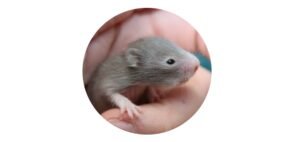How To Take Care Of A Baby Leopard Gecko
Table of Contents
Baby Leopard Gecko: All You Need To Know
Leopard geckos have gained popularity as pets as they are pretty easy to care for. If you are looking to adopt one then this article might be for you.
These healthy critters are great even for people who haven’t had a pet yet. Breeding a cute baby leopard gecko is more fun, but the owners should know about their requirements.
These intimating baby leopard geckos require the same conditions of humidity and temperature as an adult. They need to be fed daily as per the size and length rule.
They need to be cared for as they love being picked and handled and quickly form a bond with their owners.
It is critical to note that their bones are still fragile so they should be handled with care and less frequently.
How To Take Care Of A Baby Leopard Gecko?
Baby leopard geckos do share certain characteristics of their adult version but there also exist differences that pet owners should be aware of.
Feeding A Baby Leopard Gecko
Being carnivores, their diet includes insects and worms. There are 3 key elements of their diet.
How Often Should Baby Leopard Gecko Be Fed?
Adult leopard geckos need to be fed every day, but over-feeding should be avoided as it can lead to health problems like obesity that can shorten their lifespan. While in the case of baby leopard geckos it is recommended that they be fed frequently.
What To Feed Your Leopard Geckos?
They feed on insects or worms like crickets and mealworms of the correct size. Baby leopard geckos also feed on them but they require small worms that can be hard to find.
It is advised to feed them with crickets until they are big enough to eat other insects and mealworms.
Once they become adults they can feed on insects like super worms, wax worms, dubia roaches, mealworms, hornworms, phoenix Worms, and silkworms.
How Many Insects And What Size Should They Be?
Two rules should be kept in mind concerning feeding. First, a meal leopard geckos should be fed with 2 insects for every 2.54 they are long.
For instance, if the baby is 7.62 cm long, then you need to feed it with 6 insects every meal.
The second rule is concerning the size of the prey. Like with other reptiles it is important to check if the food is too large as otherwise, it can result in impaction or choking.
The cricket needs to be smaller than the space between the eyes of the leopard gecko.
Vitamin Supplements
Generally, leopard geckos are required to be given a vitamin supplement after their meal and this is crucial for baby leopard geckos. The nutrients provided by the supplements help them to develop and grow healthily.
One of the major concerns they may face is a calcium deficiency and if this is left unmonitored it can result in diseases like metabolic bone disorder, deformities, injuries, and in extreme situations even death.
Two basic supplement techniques are recommended to avoid calcium deficiencies. The sprinkle supplement like Zoo Med Calcium powder is dusted on the feed like crickets prior to feeding them.
Though less efficient nevertheless helps in increasing calcium intake. Gut loading is another technique, where the crickets are fed on a high calcium meal a day before feeding.
This is more efficient as the calcium is directly absorbed in the gut. The high calcium meal of the gecko can be kale or collard greens or Fluker’s Cricket Feed.
Baby Leopard Gecko Habitat
Their habitats are similar to the adult ones, they also do require gallons of space inside a pet enclosure. Their walls should be high so that geckos won’t be able to jump over the sides.
To get the ideal temperature an under-the-tank heater and overhead heating light can be employed. The ground temperature should be maintained at 32° C and the air temperature should be kept at 22° C during the daytime.
These nocturnal geckos absorb the required heat during the day and store it as they rest. They hunt at night and are most active at sunset, twilight, and sunrise.
They generally hunt at night. These conditions can be stimulated by utilizing the heater for 12 hours and then switching it off for another 12 hours.
UVB lights may be required for life plants but are not required by the leopard geckos. They require a relative humidity of 10-30% in the tank and the humidity levels can be assessed by a hygrometer.
If your place has a higher humidity level then a dehumidifier can be employed. The furniture should be kept lower to the ground when picking out items. As for the baby leopards, geckos may be prone to drop.
Can You Hold A Baby Leopard Gecko?
They share a bond with owners and love to be handled. Baby geckos have a fragile skeletal system that has not fully developed yet so they should be handled with care.
Compared to the adults they feel rubbery and babies should not be dropped or pressed hard. When handling baby geckos both hands should be utilized to harness them.
Geckos usually run or just fast without any notice So, be prepared for the baby to move and when handling the hands should always be placed lower. You can pick them up but don’t carry them for a longer time as it can make more struggle.
You can stroke them by gently running your hands over them while playing or touching them while they on the ground.
This would be safer for them and help them get used to your presence and scent that helps them to build a bond with their owner.
How Often Should I Handle My Baby Leopard Gecko?
The leopard gecko baby should be handled for 5 minutes maximum once every 3 days. Two handlings can be done at 2 minutes apart till 20 minutes and slowly increase it to 20 minutes every other day for taming purposes.
20 minutes maximum should be kept as the upper limit for adult geckos as even though they love being handled but don’t overdo it.
Once they reach 20 minutes every other day, this is the recommended maximum for all leopard geckos as adults. On getting stressed, they may drop their tails. The tails grow back stubbier and are not perfectly matched.
As a pet owner, you have to be prepared for jumping and running. You should interact often by stroking them but look for signs of stress. If they show stress you should give them a break.
Symptoms of stress include hiding, fast tail wagging, chirping, and biting. It is good to be aware of these signs and you will develop a good bond.
Babies and juvenile forms are readily available in pet stores so they may be able to bond well with their owners. The tank should be set regularly, they should be handled with care, and should be fed appropriate sized insects or worms.










